We’re Riding Strikingly Lower Tire Pressures
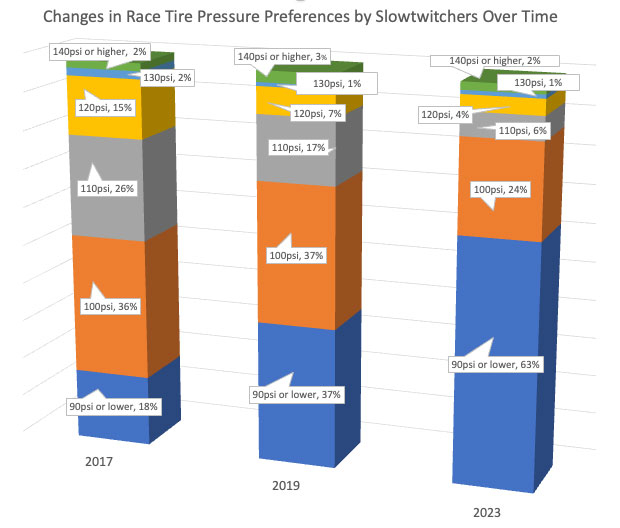
Tire pressures we choose for racing in triathlons has dropped like a rock over the past few years, but it’s not just jamming less air into the same tire. It’s also because we now have different tires. And wheels. And bikes.
Every time you upgrade your equipment we’re all smart enough to know that pressures match equipment. We know this because many of us ride gravel or mountain bikes and we know that 25psi gets pushed into our 53mm tires, 34psi in our 43mm tires, 38psi in our 38mm tires and so on (those are sample pressures, depending on a boatload of parameters). Point being, we know that “lower pressure is faster” is just as true as “higher pressure is faster.” But not always! If you raced in the 1980s, higher pressure was faster (or so we thought). The only reason we didn’t put even more air in our 19mm or 21mm sew-up tires is because we were pump-limited. And that’s for an IRONMAN. I promise you I was riding north of 120psi when I raced these tires in Kona in 1981.
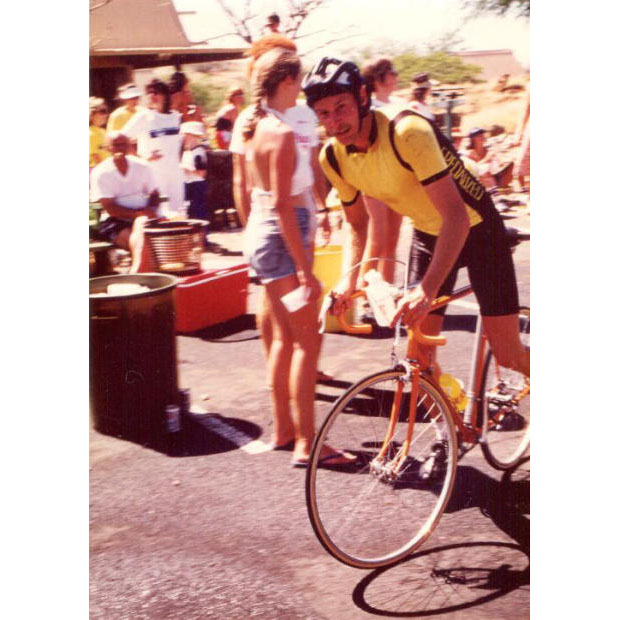
Fewer than 1 in 5 of us chose 90psi (or lower) as our chosen pressure in 2017, for racing in a triathlon. Mind, this was not that long ago. Here’s a thread on Josh Poertner’s work on wheel development for Paris Roubaix, and this thread is from 2015. That work that Josh did was published on his Silca website and the work itself (if I remember right) goes back to 2007/8. Roughly contemporaneous was Tom Anhalt preaching his tire pressure gospel – Tom was a pioneer in this – talking about breakpoint pressure in an article he wrote for Slowtwitch back in 2009. What he wrote in that article was, “above a certain pressure (what I like to call the "breakpoint pressure") higher inflation pressures make a rider slower for a given power input to the pedals.” So, there you go. The idea was out there but it took a while to percolate. Why? Josh Poertner put it perfectly: Higher pressures feel faster (he’s said many times) and if that’s been your governing principle it’s going to take time to break that habit. (I believe I read that a team manager told Josh they pumped their – perhaps track – tires to 280psi).
Had I answered this poll in 1986 I’d have written 130psi. By 2017, as we see, only 4 percent of Slowtwirtchers were riding 130psi or higher. But only 18 percent were riding 90psi or lower. When we polled this 2 years later, in 2019, the percentage of us all riding 90psi or lower had doubled, so, the message was really getting out. Since then that number has skyrocketed and 63% of us all are racing triathlons with 90psi in our tires, or less yet.
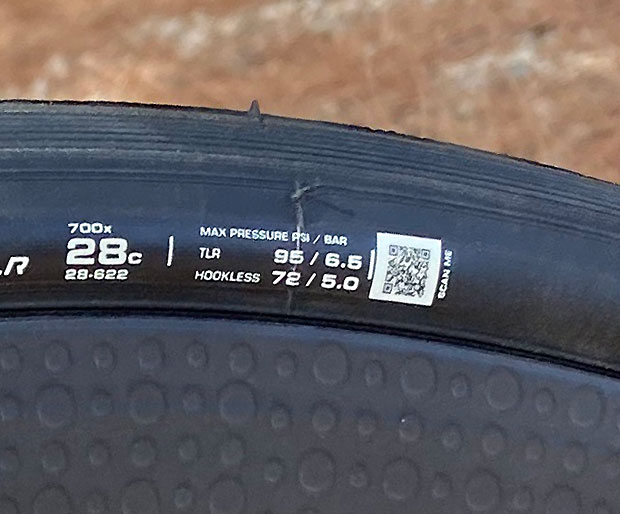
Why this move to lower pressures? Partly, it’s the educational component discussed above. Josh Poertner, Tom Anhalt, Al Morrison, Jan Heine and their ilk have been testing this, for 20 years, and telling us their results, and we’ve come to believe them more than we believe the sense that harder tires are faster. Slowtwitchers read and adopt.
But just as much it’s the change in tire and wheel width. When I was running 130psi it was in 19, 20, 21mm tires. When the tires jumped to 23mm wide the pressure dipped to around 110psi. Then we all went to 25mm tires and the pressure dropped again. As I moved from tubular to clincher, and then to tubeless, the pressures also edged down. As I moved to rims with 15mm internal bead width, to 17mm, 19mm, 21mm, and now between 22.4mm and 23mm, the same-width tire inflated wider in each successively wider rim, the air volume grew, and the pressure decreased accordingly.
The other thing that happened is that I moved to rims with hookless beads. Big controversy here! Which I won’t go into because it’s been discussed in so many other places. Just, this pushes the pressured down in my wheels another 3psi or so, and in some tire pressure calculators it’s more like 5psi. Speaking of calculators, I wrote about these here, and specifically about the variances between the manufacturer’s calculators (ENVE, CADEX, Zipp) and the slightly higher pressures you get from the Silca calculator.
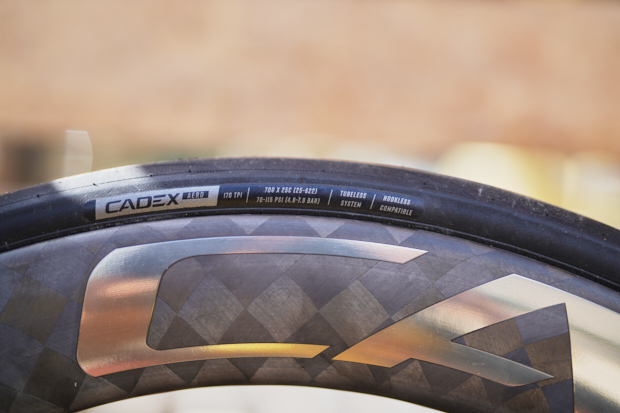
But here’s the thing: Even with Silca’s “high-trending” pressures, if you take me, 190lb worth of bike, gear and body weight, 25mm tire, a fast smooth road, I’m either 98psi or 99psi based on my race speed. Worn pavement and I’m down to 93psi. And the data field this calculator doesn’t have is rim inner bead width, so, if you imagine today’s rims, with that width at 21mm to 23mm, you’re probably at 90psi or lower and that’s on a 25mm tire. So, unless you’re riding a 23mm tire it’s hard to imagine the justification for any triple-digit pressure.
And this is why the pressures we all choose are what they are. With just about two-thirds of you riding at 90psi or lower, the next time we poll this we’ll ratchet down the pressure options, and probably have 60psi or lower, 70psi, 80psi, 90psi, 100psi, and then 110psi and higher. About 45 percent of us fit into that last threshold – 110psi and higher – back in 2017. That number shrank to 25 percent in 2019 and only 13 percent of us are riding at 110psi or higher today. It’s hard to imagine 110psi being outlier-high, but that’s where we are today.


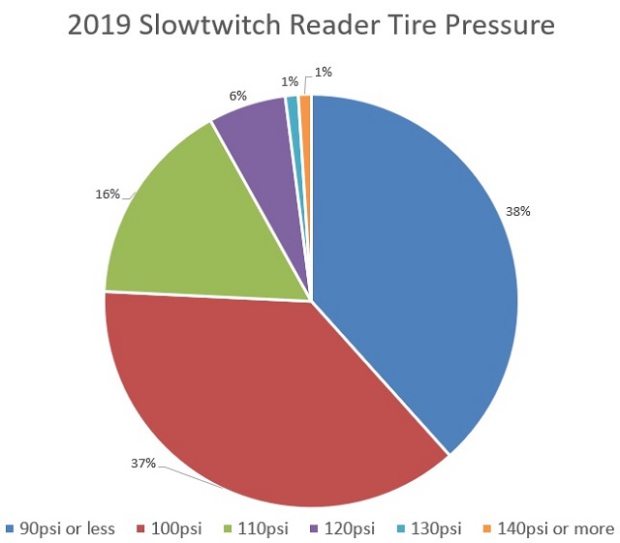
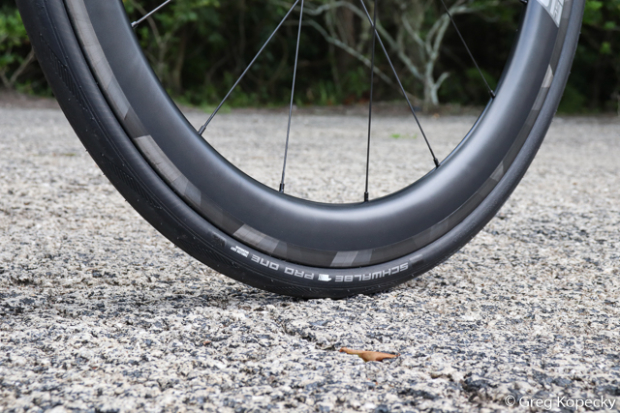
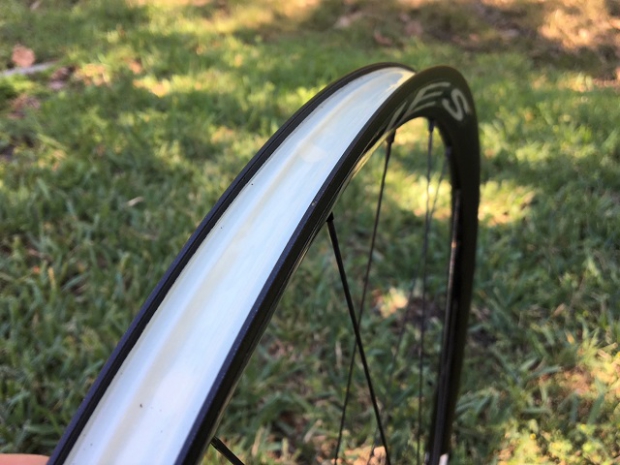
Start the discussion at slowtwitch.northend.network